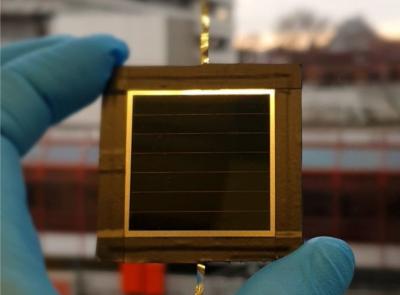Researchers at the Karlsruhe Institute of Technology (KIT) in Germany have fabricated a spin-coated, two-terminal, all-perovskite tandem solar module with an aperture area of 12.25 square centimeters and a geometric fill factor of 94.7%. The team said that laser-scribed two-terminal all-perovskite tandem (2TPT) solar cells have attracted attention in recent years, as they combine a wide bandgap perovskite top subcell with a narrow-bandgap perovskite bottom subcell.
The scientists used a 23-5% efficient 2TPT solar cell based on perovskite and copper/indium/selenium (CIS) thin-film, which they first announced in June. It has an open-circuit voltage of 1.59 V, a short-circuit current of 19.4 mA cm–2, and a fill factor of 75.5%.
The researchers used a custom-built laser-scribing set-up for the production of the monolithic interconnections of the solar modules.
“The set-up allows patterning in an inert atmosphere to prevent oxygen exposure and degradation of the narrow bandgap bottom subcell during the scribing process,” they said, noting that they used vacuum-assisted growth control (VAGC) to extract all solvents in the deposition process of the bottom cell on top of the top cell. The team said the module interconnections had a minimal impact on the device's performance, which resulted in an open-circuit voltage loss of only 10 mV per cell stripe.
“Our modules retain a high fill factor of 75%, demonstrating a negligible detrimental effect of introduced module interconnections,” they said.
The solar module achieved a power conversion efficiency of 19.1% and a smaller version with an aperture area of 2.56 square centimeters reached an efficiency of 22.2%.
“The prototype module presents 95% of initial power conversion efficiency for 15-hout MPP tracking under continuous AM 1.5G illumination,” the scientists said.
They introduced the module in “Scalable two-terminal all-perovskite tandem solar modules with a 19.1% efficiency,” which was recently published in Nature Energy.
“By means of electroluminescence imaging and laser-beam-induced current mapping, we demonstrate the homogeneous current collection in both subcells over the entire module area, which explains low losses in open-circuit voltage and fill factor for our scalable modules,” they said.


